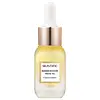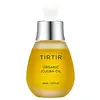What's inside
What's inside
 Key Ingredients
Key Ingredients

 Benefits
Benefits

 Concerns
Concerns

 Ingredients Side-by-side
Ingredients Side-by-side

Coco-Caprylate/Caprate
EmollientHelianthus Annuus Seed Oil
EmollientTriethylhexanoin
MaskingTocopheryl Acetate
AntioxidantSqualane
EmollientDicaprylyl Carbonate
EmollientGlyceryl Caprylate
EmollientSimmondsia Chinensis Seed Oil
EmollientCaprylyl Glycol
EmollientElaeis Guineensis Oil
EmollientPersea Gratissima Oil
Skin ConditioningVitis Vinifera Seed Oil
EmollientCeramide EOP
Skin ConditioningCeramide Ns
Skin ConditioningCeramide Ng
Skin ConditioningCeramide As
Skin ConditioningCeramide AP
Skin ConditioningCeramide NP
Skin ConditioningLimnanthes Alba Seed Oil
Skin ConditioningCamellia Japonica Seed Oil
EmollientSclerocarya Birrea Seed Oil
HumectantMacadamia Integrifolia Seed Oil
Skin ConditioningRosa Canina Fruit Oil
EmollientPlukenetia Volubilis Seed Oil
EmollientTocopherol
AntioxidantButyrospermum Parkii Butter
Skin ConditioningHydrogenated Lecithin
EmulsifyingDipropylene Glycol
HumectantSucrose Distearate
EmollientCholesterol
EmollientCoco-Caprylate/Caprate, Helianthus Annuus Seed Oil, Triethylhexanoin, Tocopheryl Acetate, Squalane, Dicaprylyl Carbonate, Glyceryl Caprylate, Simmondsia Chinensis Seed Oil, Caprylyl Glycol, Elaeis Guineensis Oil, Persea Gratissima Oil, Vitis Vinifera Seed Oil, Ceramide EOP, Ceramide Ns, Ceramide Ng, Ceramide As, Ceramide AP, Ceramide NP, Limnanthes Alba Seed Oil, Camellia Japonica Seed Oil, Sclerocarya Birrea Seed Oil, Macadamia Integrifolia Seed Oil, Rosa Canina Fruit Oil, Plukenetia Volubilis Seed Oil, Tocopherol, Butyrospermum Parkii Butter, Hydrogenated Lecithin, Dipropylene Glycol, Sucrose Distearate, Cholesterol
Water
Skin ConditioningGlycerin
HumectantButylene Glycol
HumectantPentylene Glycol
Skin Conditioning1,2-Hexanediol
Skin ConditioningGlycereth-26
HumectantCentella Asiatica Extract
CleansingChondrus Crispus Extract
Skin ConditioningC12-14 Pareth-12
EmulsifyingSaccharum Officinarum Extract
MoisturisingAlpha-Glucan Oligosaccharide
CleansingTrehalose
HumectantCarbomer
Emulsion StabilisingCaprylyl Glycol
EmollientPanthenol
Skin ConditioningTromethamine
BufferingPolymnia Sonchifolia Root Juice
Skin ConditioningSilica
AbrasiveEthylhexylglycerin
Skin ConditioningMaltodextrin
AbsorbentDisodium EDTA
Xanthan Gum
EmulsifyingMelia Azadirachta Leaf Extract
Skin ConditioningCitrus Aurantium Bergamia Fruit Oil
MaskingMadecassoside
AntioxidantLavandula Hybrida Oil
EmollientSalvia Sclarea Oil
MaskingSodium Hyaluronate
HumectantMelia Azadirachta Flower Extract
Skin ConditioningLactobacillus
Skin ConditioningCollagen
MoisturisingAsiaticoside
AntioxidantAsiatic Acid
Skin ConditioningMadecassic Acid
Skin ConditioningLeuconostoc/Radish Root Ferment Filtrate
AntimicrobialTocopherol
AntioxidantHyaluronic Acid
HumectantHydrolyzed Hyaluronic Acid
HumectantHydrolyzed Sodium Hyaluronate
Skin ConditioningHydroxypropyltrimonium Hyaluronate
Potassium Hyaluronate
Skin ConditioningSodium Hyaluronate Crosspolymer
HumectantSodium Acetylated Hyaluronate
HumectantPolysorbate 80
EmulsifyingCaprylic/Capric Triglyceride
MaskingGuaiazulene
AntimicrobialPhospholipids
Skin ConditioningCeramide NP
Skin ConditioningCholesterol
EmollientArginine
MaskingPhytosterols
Skin ConditioningWater, Glycerin, Butylene Glycol, Pentylene Glycol, 1,2-Hexanediol, Glycereth-26, Centella Asiatica Extract, Chondrus Crispus Extract, C12-14 Pareth-12, Saccharum Officinarum Extract, Alpha-Glucan Oligosaccharide, Trehalose, Carbomer, Caprylyl Glycol, Panthenol, Tromethamine, Polymnia Sonchifolia Root Juice, Silica, Ethylhexylglycerin, Maltodextrin, Disodium EDTA, Xanthan Gum, Melia Azadirachta Leaf Extract, Citrus Aurantium Bergamia Fruit Oil, Madecassoside, Lavandula Hybrida Oil, Salvia Sclarea Oil, Sodium Hyaluronate, Melia Azadirachta Flower Extract, Lactobacillus, Collagen, Asiaticoside, Asiatic Acid, Madecassic Acid, Leuconostoc/Radish Root Ferment Filtrate, Tocopherol, Hyaluronic Acid, Hydrolyzed Hyaluronic Acid, Hydrolyzed Sodium Hyaluronate, Hydroxypropyltrimonium Hyaluronate, Potassium Hyaluronate, Sodium Hyaluronate Crosspolymer, Sodium Acetylated Hyaluronate, Polysorbate 80, Caprylic/Capric Triglyceride, Guaiazulene, Phospholipids, Ceramide NP, Cholesterol, Arginine, Phytosterols
 Reviews
Reviews

Ingredients Explained
These ingredients are found in both products.
Ingredients higher up in an ingredient list are typically present in a larger amount.
Caprylyl Glycol is a humectant and emollient, meaning it attracts and preserves moisture.
It is a common ingredient in many products, especially those designed to hydrate skin. The primary benefits are retaining moisture, skin softening, and promoting a healthy skin barrier.
Though Caprylyl Glycol is an alcohol derived from fatty acids, it is not the kind that can dry out skin.
This ingredient is also used as a preservative to extend the life of products. It has slight antimicrobial properties.
Learn more about Caprylyl GlycolCeramide NP is a type of ceramide and formally known as ceramide 3.
Ceramides are intercellular lipids naturally found in our skin that bonds dead skin cells together to create a barrier. They are known for their ability to hold water and thus are a great ingredient for dry skin.
Ceramides are an important building block for our skin barrier. A stronger barrier helps the skin look more firm and hydrated. By bolstering the skin ceramides act as a barrier against irritating ingredients. This can help with inflammation as well.
If you would like to eat ceramides, sweet potatoes contain a small amount.
Read more about other common types of ceramides here:
Ceramide AP
Ceramide EOP
Cholesterol is a class of organic molecules called lipids. It helps hydrate your skin and is essential to having a healthy skin barrier.
Our skin naturally contains cholesterol in the outermost layer. Besides cholesterol, it also contains ceramides and fatty acids. Cholesterol makes up about 1/4 of your skin's outer layer and barrier. Your skin barrier is responsible for keeping allergens and microbes out. Having a healthy skin barrier is also responsible for keeping your skin firm and plump.
Our bodies use cholestrol to create vitamin D, steroid hormones, and more.
Learn more about CholesterolTocopherol (also known as Vitamin E) is a common antioxidant used to help protect the skin from free-radicals and strengthen the skin barrier. It's also fat soluble - this means our skin is great at absorbing it.
Vitamin E also helps keep your natural skin lipids healthy. Your lipid skin barrier naturally consists of lipids, ceramides, and fatty acids. Vitamin E offers extra protection for your skin’s lipid barrier, keeping your skin healthy and nourished.
Another benefit is a bit of UV protection. Vitamin E helps reduce the damage caused by UVB rays. (It should not replace your sunscreen). Combining it with Vitamin C can decrease sunburned cells and hyperpigmentation after UV exposure.
You might have noticed Vitamin E + C often paired together. This is because it is great at stabilizing Vitamin C. Using the two together helps increase the effectiveness of both ingredients.
There are often claims that Vitamin E can reduce/prevent scarring, but these claims haven't been confirmed by scientific research.
Learn more about Tocopherol